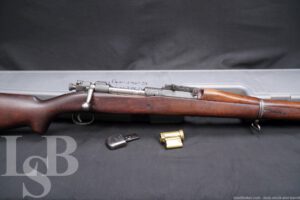
Springfield Armory Model 1903 NM National Match Bolt Action Rifle, 1923 C&R
SOLD FOR: $2,725
LSB#: 231106DL003
Make: Springfield Armory
Model: 1903
Serial Number: 1255129
Year of Manufacture: 1923 (page 374 of Joe Poyer’s book, The M1903 Springfield Rifle and its Variations) Barrel Date 3 – 28
Caliber: .30-06 Springfield
Action Type: Bolt Action, Internal Magazine
Markings: The top of the receiver is marked “U.S. / SPRINGFIELD / ARMORY / MODEL 1903. / 1255129”. The lower lip of the muzzle is marked with a “star”. Star gauged barrels were installed on M1903 National Match rifles. The top of the barrel is marked “S A / flaming bomb / 3 – 28”. The safety is marked “SAFE READY” and the magazine cutoff is marked “ON OFF”. The bolt is etched with the serial number. The bayonet lug is stamped “H”. The right side of the barrel band is marked “U”. The front of the grip is marked with a faded “circled P” firing proof. The left side of the stock above the trigger is marked “D.A.L”. This is the inspection mark of David A. Lyle (1916-1942).
Barrel Length: Approximately 24 Inches
Sights / Optics: The front sight is a pinned blade. The rear sight is a “U” notched blade attached to a fully adjustable sight ladder marked from “3-27”. When flipped up separate notches and an aperture on the ladder can be used for sighting.
Stock Configuration & Condition: The two piece, oil stained hardwood has a pistol grip, metal nosecap, stacking loop, barrel band, two sling loops, two through bolts and a metal buttplate with hinged door for storage. The stock shows some light scrapes, scuffs and compression marks. There is a notable impact on the right side of the buttstock and a notable compression on the bottom of the forend ahead of the barrel band. The LOP measures 13 1/8 inches from the front of the trigger to the back of the checkered steel buttplate. The stock rates in about Very Good-Plus overall condition.
Type of Finish: Parkerized
Finish Originality: Original
Bore Condition: The bore is bright. The rifling is deep. There is some light frosting near the muzzle. The bore shows an M.E. of 0.5. In this writer’s opinion, this bore rates a 10 out of 10.
Many military and C&R-eligible weapons have bores that will show erosion. This is not only due to age but to the fact that corrosive primers were commonly used in ammunition worldwide. For example, the U.S. used corrosive ammunition throughout WWII. The U.S. military did not begin to phase out corrosive-primed ammunition until the 1950s.
Overall Condition: This rifle retains about 95% of its metal finish. The barrel and front sight show thinning, discoloration and scrapes. The bottom metal shows a small scratch and some light scrapes. The receiver shows some light thinning and light scrapes. The buttplate shows some discoloration. Some of the screw heads show use. The markings are deep. Overall, this rifle rates in about Very Good to Fine condition.
Mechanics: The action functions correctly. We have not fired this rifle. We have cleaned this firearm and performed a mechanic’s check but expect many will want to clean the firearm again depending on their standards.
Box, Paperwork & Accessories: The rifle comes with a P.J. O’hare muzzle/front sight protector and rear sight protector as well as a Gun Guard hard case. One of the latches on the case is broken.
Our Assessment: This Springfield Armory Model 1903 NM is a National Match rifle. It was factory reconditioned at Springfield Armory after it was used as a competition rifle. It has a “star gauged” barrel. This rifle looks great and has nice deep markings. It will make a collector very happy. Here is some information on National Match Rifles from Wikipedia: “…selected rifles produced at Springfield Armory for National Match shooting competition. Production barrels were measured with star-gauges, and those meeting specified tolerances were stamped with an asterisk shaped star on the muzzle crown. These barrels were fitted to selected receivers with hand-fitted and polished parts. The bolt was left unblued while the receiver and barrel were finished with a black Parkerizing process. Some bolts have the safety direction reversed to prevent it from striking the nose of a right-handed shooter, and those made from 1924 to 1929 have the knurled cocking piece removed to decrease lock time. Early rifles used the type S stock until the type C stock became standard in 1929. Rifles made for sale to NRA members (priced at $40.44) were drilled and tapped for a Lyman 48 receiver sight and had either a type B (or NB) stock with no grasping grooves and a noticeable drop at the heel for a long pistol grip, or a special National Match stock with a high comb and pistol grip. Total production was 28,907. Most were issued to service teams and 25,377 were reconditioned at Springfield armory after one year of match use. Reconditioned rifles have a large gas-escape port drilled into the left side of the receiver.” Please see our photos and good luck!
-Greenfield

